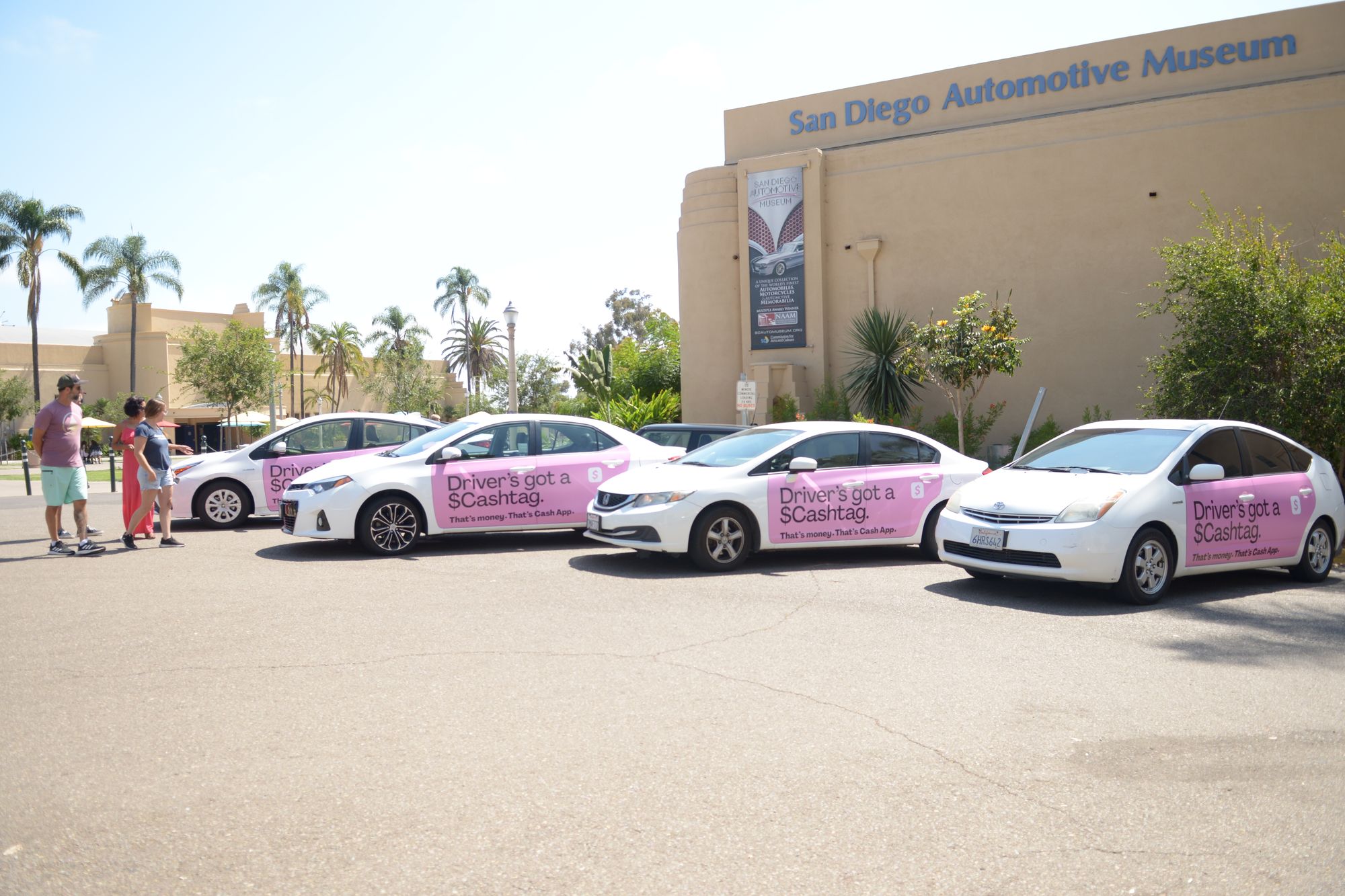Q+A: The 360 On Wrapped Ride Share Vehicles

Look out Kings, Queens, and USKs — there are new media formats taking the roads by storm. Wrapped rideshare vehicles have been gaining popularity amongst brands and media planners and now the upstarts offering this media format are bringing standardization to the placement.
For years, industry groups have promoted standards and measurements for traditional OOH products. While transit is considered traditional OOH, measuring and standardizing these products has been tricky given that the inventory moves, may be scaled quickly, and offers a variety of size and placement options.
Recently, executives from mobilads, Wrapify, Carvertise, and other mobility companies gathered to standardize one of the fastest-growing products in the Out-of-Home advertising space: vehicle wraps. They're nimble, they're measurable, and they can be anywhere your outdoor audience is.
AdQuick’s Head of Business Development, Katie Burwell, recently sat down with Niels Sommerfeld, co-founder & COO at mobilads to talk about the new standards.
Katie: Transit advertising is a massive category. Media buyers typically think of buses, subways, and rail, rather than for-hire vehicles. Can you tell us a little bit about mobilads and how you got into the car wrapping business?
Niels: My co-founder, Craig Cook, pitched me the idea in 2019. Living in NYC, we noticed that the greatest brands in the world were utilizing real estate on transit – bus wraps, subways, taxi tops – to advertise to their audience IRL. At the time Uber was booming (80K Ubers in NYC, 3M in the US) but no one was advertising on these vehicles. We saw an opportunity to leverage this massive network of untapped real estate and use it as a canvas for brands to reach their audience in a unique way, while putting income into the pockets of gig workers who need it.
So why did we choose wraps? Our focus is speed-to-market. Wraps allow us to create inventory overnight and scale campaigns anywhere in the US without all of the upfront capex required for hardware or legal complexities that most media vendors face. Wraps are also big, eye-catching, and memorable which we learned is what brands want.
K: I love when a seed is planted amongst friends. What led to the conversations around standardizing this format? Who was involved?
N: The initiative was led by some of the top players in rideshare advertising — Wrapify, Firefly, mobilads — to help make it easier for media advertisers to buy vehicle wraps. Our format falls into a unique space that most internal agency teams are unfamiliar with, which makes it a challenge to educate them on this new category that we’re building… especially since we’ve all been using different wrap names and variants. Standardizing it helps our members quantify the value and impact of their investment, compare apples to apples across Out-of-Home media options, and ultimately bring credibility to the medium — similar to what happened with bus wraps 40 years ago.
K: It's great to see the collaborative effort here! As a team that buys media and builds an OOH platform, we know one of the best ways to scale is through alignment and understanding the unique attributes of all sorts of OOH. So let’s get into some of the new standards. Can you tell us a bit more about the products?
N: Media buyers can now easily compare the attributes across a grid of multiple options on an RFP. The size and placements of the ad on the vehicle are the main focus here.
- 180: a half wrap that covers front and rear doors of both the driver and passenger side which is about 40” x 100” in ad size on each side. This is our most popular and cost-effective product.
- 270: includes ad space on the doors, plus the rear quarter panels and rear bumper/trunk/hatch.
- 360: a full wrap that covers the entire vehicle aside from the roof, providing the fullest vehicle coverage available.
There are also some add-ons to enhance the branding on the car like a rear-window (RW) panel. We will use various combinations of the wrap types and corresponding add-ons (i.e. 360 + RW, 180, etc.)

K: What is important for buyers to keep in mind when planning a wrapped vehicle campaign?
N: We talked about the ad size and placement, but the behavior of the vehicle is what really matters. mobilads offers two deployment strategies that engage differently depending on the campaign goals.
- A mass awareness campaign is DMA-focused and utilizes a large fleet of cars to take over a market and reach pockets of the city where traditional OOH can’t. By piggybacking off rideshare apps and their drivers (fully vetted, commercially insured, required to drive 40+ hours per week), we can guarantee that your brand is reaching a wider audience and is always where the crowd is.
- A blitz campaign is all about reaching large concentrations of a specific audience in real life during culturally-relevant moments. It focuses on Event Marketing Areas (EMAs), which are areas within DMAs made up of major live events that contain your target audience. Once you decide on an event, we send your branded cars to swarm the venue at key moments to make a splash with the audience. We’ve been seeing a lot of demand for Blitz campaigns — most clients do a combination of these two strategies to maximize their impact.
K: It's fun seeing wraps in the wild and we have clients that love their wrapped cars! What should brands newer to the medium know about the product?
N: Music to my ears! Nothing better than a satisfied client. We’re finally seeing momentum with this category. Fortune 500 brands and early-stage companies across various industries are having success using our format. Most of our clients view mobilads as a “moment-based” OOH partner that supplements their existing media strategy – we actually encourage traditional billboards and other digital channels to be used in conjunction with vehicle wraps to boost the ROI.
A common misconception of our medium is that it’s slow to launch, which couldn’t be further from the truth! Since we operate entirely in-house, we’re able to launch campaigns of any size nationwide with turnaround times comparable to digital mediums. We receive last-minute campaign requests all the time that we launch within three days of receiving the artwork – and our goal is to continue shortening that window.
K: Let’s talk some more about the measurement. How can wrapped vehicles be measured like other OOH products or other media channels?
N: Our approach to measurement is aligned with industry standards for traditional billboards. The main difference is that our vehicles are always moving, so we have to factor in matching two constantly moving, massive datasets to calculate impressions.
We collect first-party GPS data every few seconds from our vehicles and combine it with third-party mobile location data to determine the likelihood of who was in viewing distance of the ads. We then measure outcomes, such as lift in foot traffic (by geofencing) and online conversions (by placing a pixel) attributable to the OOH exposure, and use beautiful heatmaps to showcase campaign coverage. One day we’ll be able to show all of this in real-time, and alongside other digital channels, so marketers can make split-second decisions throughout a campaign.
Standardization will allow third-party data providers to establish a baseline when measuring our media.
K: I know you have some busy weeks around events like the Super Bowl, F1, SXSW- what is the largest campaign you have deployed for a brand?
N: Super Bowl has been our holy grail event since mobilads launched in 2019. We just launched a city-wide takeover campaign for DraftKings and He Gets Us at Super Bowl LVII. More than 265 wrapped cars generated 50+ million impressions throughout Phoenix while swarming Staples Stadium on game day – at a fraction of the cost of a sponsorship or TV ad.
K: Huge events are such a great platform for out-of-home and these vehicles offer a really creative outlet. Is there anything you want to do that hasn’t been bought or executed yet?
N: We’d love to run a nation-wide, event-based campaign where a brand chooses multiple markets entirely based on major live events that contain their audience, and swarm those events throughout the year… maybe incorporate live digital retargeting at each event to amplify and measure the impact at a large scale.
K: Let’s get on that! Anything parting thoughts?
N: We’re huge fans of the AdQuick platform. Your team has been instrumental in mobilads' success over the last two years. OOH is an exciting industry right now and we’re grateful to be a part of the ride. Lovely chatting with you!
K: And we're big fans of yours! Thanks!
Happy wrapping!

